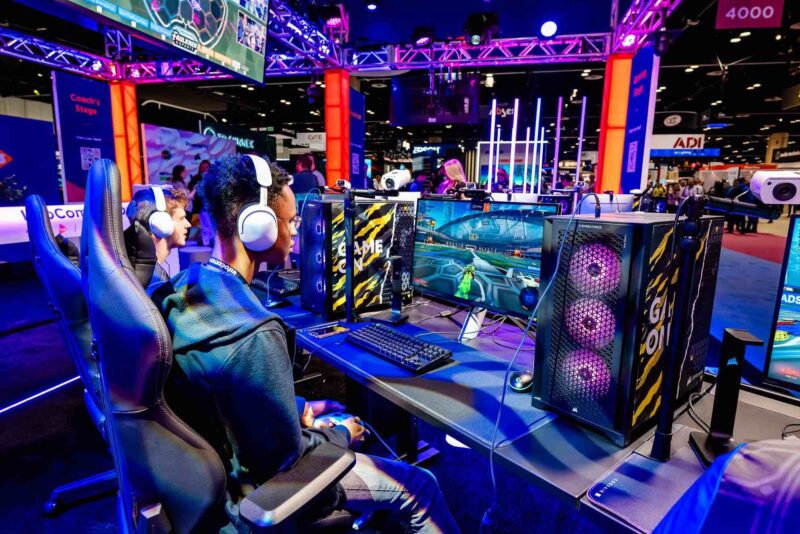How-To Esports: The Blog
 Hello, readers! On April 15, I hosted a webinar with Almo Pro A/V and Steve Milley from Panasonic (this company plays a huge part in the esports and gaming market). And, as promised, I’m including written versions of each webinar, so you don’t miss out on the content — even when the webinar fills up to capacity like it did yesterday.
Hello, readers! On April 15, I hosted a webinar with Almo Pro A/V and Steve Milley from Panasonic (this company plays a huge part in the esports and gaming market). And, as promised, I’m including written versions of each webinar, so you don’t miss out on the content — even when the webinar fills up to capacity like it did yesterday.
So, to our point — esports! What are they? Where did they come from? Where are they going? Who are they for?
First thing’s first. The majority of the esports market uses AV-over-IP — so it may behoove you to attend my webinar Friday on just that! (You can register for The Only Unbiased Explanation of AV-over-IP here.) The second thing to understand is that esports get negative press — and therefore have a connotation of only being for kids who don’t do well in school, or for bored kids sitting in their parents’ basements — but that’s not true. That’s an old way of looking at this market, and before you and your company can find a place in it, you have to throw this way of thinking out the window.
Egaming vs. Esports
These are two completely different things, and it’s essential to understand the difference. Think of the egaming market as a giant umbrella that’s worth more than the entire movie market with concessions included. It includes the platforms on which you, the user or player, play different virtual games. These platforms can be your mobile phone, Xbox, Nintendo, PlayStation, etc.
Under this umbrella are different virtual games, divided by the platforms mentioned above.
Then, under that, competitive teams are playing against each other in real-time. You can filter that again by gaming platform, then by leagues for each game. (Sometimes specific big-name players can cross into different leagues, but most esports players stay in specific leagues for the games that they specialize in.)
Esports is the bottom of the funnel — specializing in competitive egame playing in real-time. Keep in mind; not all games are esports qualified. There have been issues based around what egames qualify for participation in an esports venue and what don’t.
In this column, I’m only going to focus on this live event portion — aka the portion that was worth $1.4 billion at the end of 2019. Esports has 335 million players and viewers around the world (some countries are more involved than others. South Korea is one of the biggest). These live, competitive games are usually streamed on several public platforms, like Twitch, but some gaming companies like Epic Games have their own streaming platform. Make no mistake by assuming no one outside of gaming companies care about this. Fox Sports and ESPN are in the process of investing in this market (even though ESPN was putting together a division for this and subsequently cut it about three years ago). I think we will see more common sports-based companies realize they missed the mark as we enter our current world state.
Esports and COVID-19
Esports grew by 9% last year — but now, that data is changing drastically because of COVID-19. The reason this is happening is pretty apparent. In essence, people are no longer able to participate in their regularly scheduled sports, and esports are able to pick up the slack in the fanbase. Plus, esports are for everyone. There are competitive players of all ages, and there are teams for high schoolers, college students, young adults and beyond.
Here’s an example of esports are picking up the slack right now. NASCAR races are shut down because of the pandemic, but this sport was prepared. For every scheduled NASCAR race, those same drivers that fans know and love were racing those courses but virtually. Fox Sports broadcasted these races with drivers on headsets still communicating with their pit crews, even having to pit and occasionally crash, and still having winners and losers. This is working because NASCAR already has a built-in audience who are incredibly loyal and will gladly follower their chosen driver to a virtual realm.
We can expect to see a lot more of this in the near future.
Where AV and Esports Meet
Although the interest in esports right now is stemming from the fact that they are entirely virtual, egaming and esports are merging more each day. Physical arenas and stadiums are being filled with audiences who want to watch these competitive games. I can’t stress this enough — it’s no longer a sport for geeks — 120 universities in the U.S. have esports teams, and some are even varsity!
Plus, all the egaming platforms are becoming part of the esports ecosystem. Big, well-known companies like Panasonic, Epic Games, Apple and Disney are developing products directly and specifically for this market. Mix this with a general public, full of people who are looking for something new to follow during this time in history, and we have the perfect environment for esports to thrive. The AV industry just needs to jump on it.
What do those products look like, and how can AV fit in?
First stop: arenas. Although esports don’t require an arena, it’s an excellent place to start. These dedicated arenas all have AV inside of them. Most products use AV-over-IP and need specific equipment that many companies are equipped to make.
For instance, during live tournaments, players need products that have no delay or latency. Plus, closed servers are important because hackers are everywhere. Our industry can help! Companies can offer products to the market for spectators or a live audience. Although some companies like Epic Games prefer to control what the spectator or audience sees, there are still plenty of opportunities to offer these companies products that will work with their games.
A great example of a well-done esports arena is the Full-Sail Fortress.
Takeaways
TL;DR: Esports are coming, and we need to be ready. This market will be looking for products with no latency, lag or compression — so hop on the train or get left behind.
This is part of a series, so look out for my next esports webinar and corresponding column. Also, my AV-over-IP webinar will be on April 17, and I’m looking forward to seeing you there.





